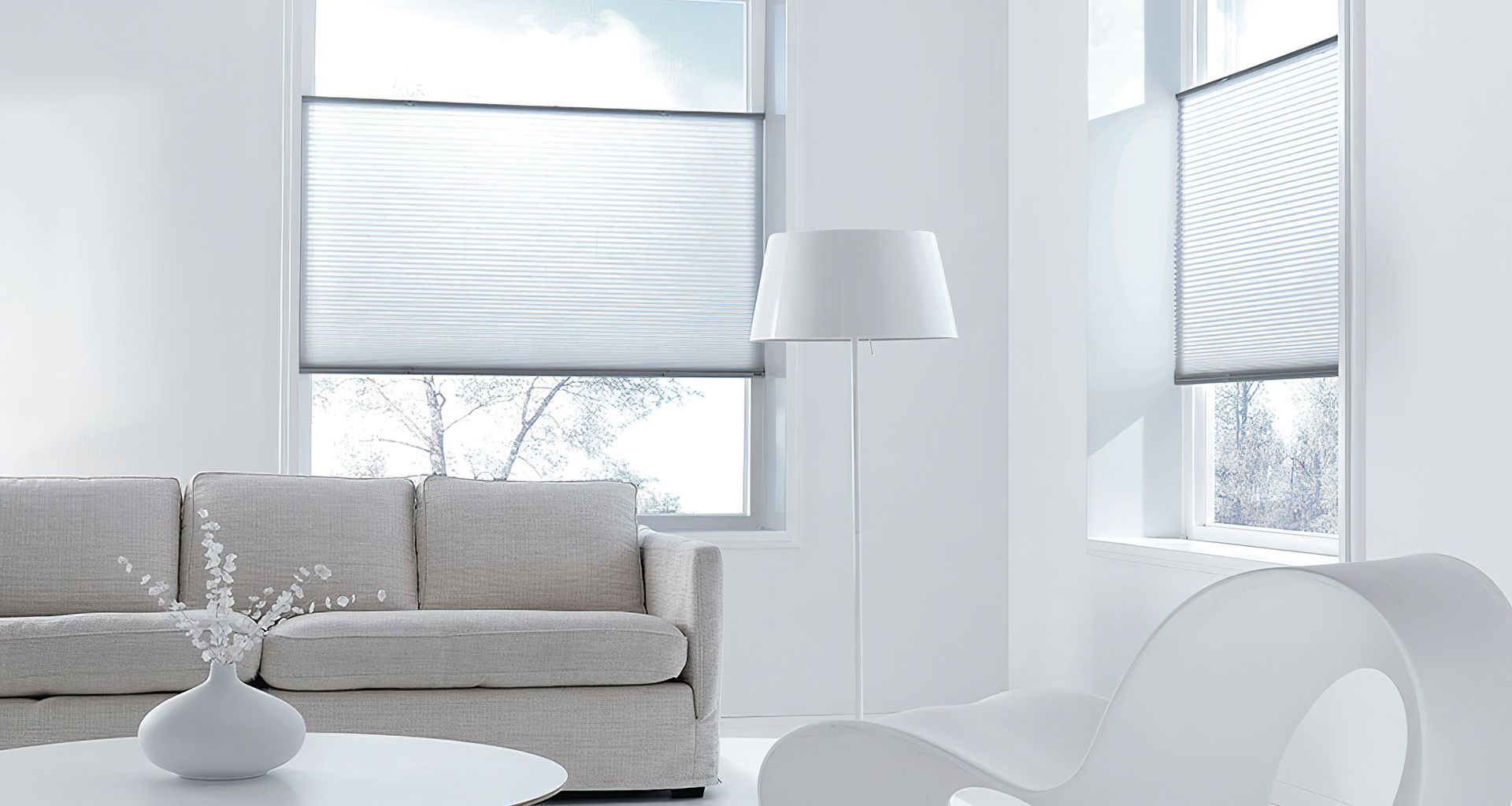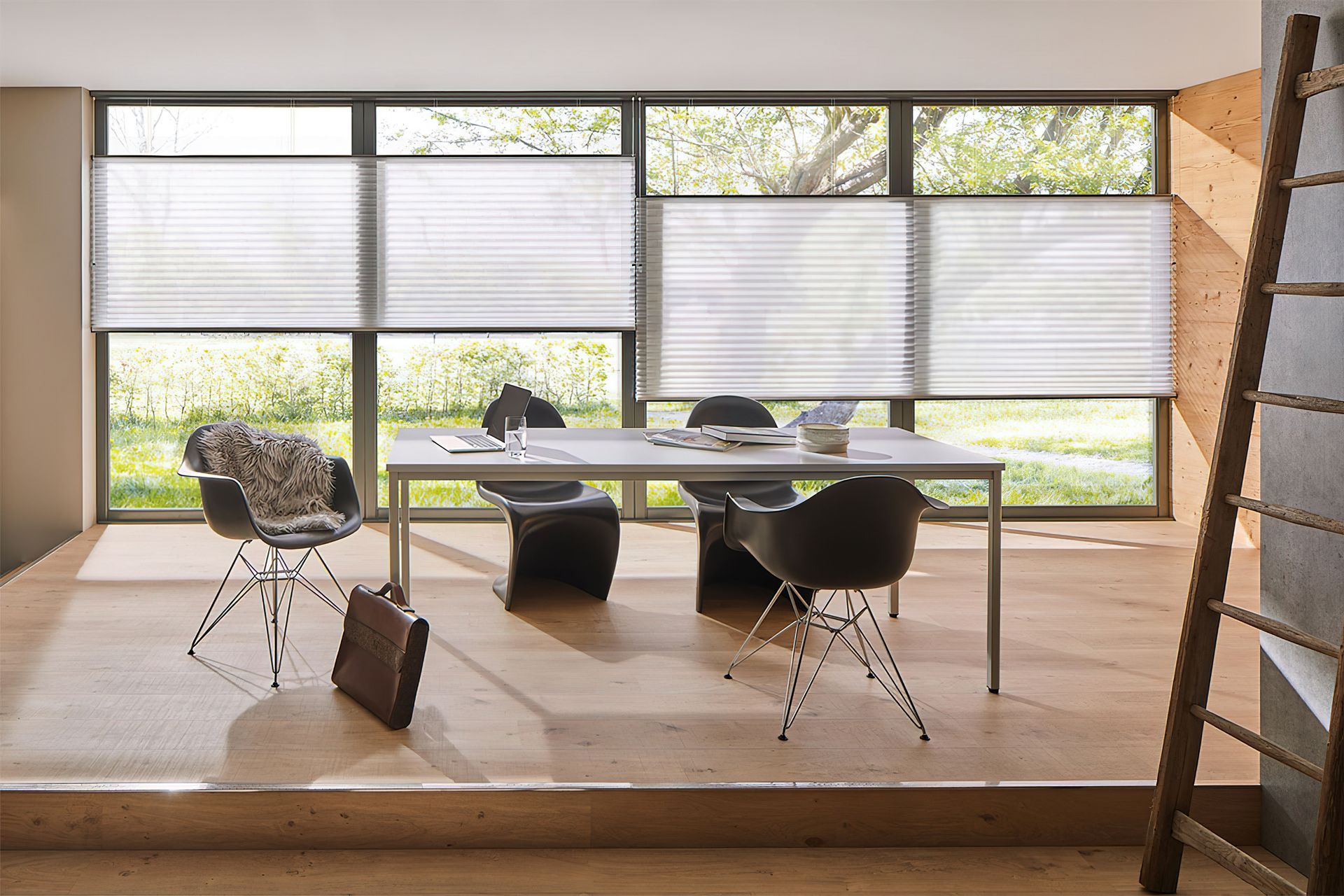What are honeycomb blinds? An introductory guide

Choosing new blinds or shades for your home is never an easy decision. You want a solution that will not only effectively regulate light entering your room but also enhance your space's overall aesthetics and atmosphere. One type of window shade that fulfils these requirements is honeycomb blinds, an innovative, stylish window fashion with impressive insulating and design properties.
What are honeycomb blinds?
Honeycomb blinds are window furnishings characterised by a unique structure consisting of individual honeycomb-shaped cells connected together. These cells create a honeycomb-like pattern designed to provide enhanced thermal insulation, regulate temperature, and offer light control options by adjusting the amount of light entering a room. They are popular for homeowners looking for window treatments that offer energy efficiency, privacy, and customisable light filtration.

How do honeycomb blinds work?
Honeycomb blinds utilise a unique cellular structure to provide insulation and control light. The blinds consist of multiple layers of fabric that are interconnected to form cells, resembling a honeycomb or beehive.
The cells of honeycomb blinds create pockets of trapped air. These air pockets act as insulators, preventing heat transfer between the interior and exterior of a room. When the blinds are fully extended, the cells expand and trap a significant amount of air, enhancing their insulating properties.
During hot weather, honeycomb blinds block and reflect sunlight, preventing it from entering the room. This helps to keep the room cool by reducing the amount of heat transferred from the outside. In colder seasons, the blinds act as a barrier against cold air, minimising heat loss from the room and providing insulation to maintain a warmer indoor environment.
The size of the cells in honeycomb blinds can vary, with larger cells providing increased insulation and smaller cells offering a more compact and sleek appearance. The blinds can also come in different opacities, allowing for varying degrees of light control and privacy.
To operate honeycomb blinds, they can be raised or lowered using a cord system or with cordless options. Some models even offer motorised mechanisms for convenient control. By adjusting the blinds, you can easily regulate the amount of natural light entering the room and customise your desired level of privacy.

What are the advantages of honeycomb blinds?
Cellular structure and design
As you might have guessed honeycomb blinds derive their name from their distinct cellular structure. This honeycomb design consists of hexagonal cells that are connected, creating a series of air pockets. These cells trap air, forming a layer of insulation between the window and the room. The structure plays a crucial role in the energy efficiency of these blinds.
Energy efficiency and cost savings
One of the primary benefits of honeycomb blinds is their energy efficiency. The trapped air within the cells acts as a barrier, preventing heat transfer between the interior and exterior of your home. As mentioned earlier, honeycomb blinds keep the hot air out to keep you cool in summer, while in the colder months, they prevent heat from escaping to keep you warm in winter, resulting in a more comfortable living space. By reducing the need for excessive heating and cooling, honeycomb blinds can help you save on energy costs and promote energy efficiency.
Light control and privacy options
Honeycomb blinds offer versatile light control options, allowing you to customise the ambience in your room. Depending on your preferences, you can choose from various fabric opacities, including light-filtering and blackout options. Light-filtering honeycomb blinds gently diffuse natural light, creating a soft and inviting atmosphere, while blackout honeycomb blinds provide complete darkness, perfect for bedrooms or media rooms. Furthermore, honeycomb blinds enhance privacy by preventing outsiders from peering into your living space.

Noise reduction and soundproofing
If you live in a noisy environment, honeycomb blinds can reduce the amount of external noise that enters your home. The cellular structure of these blinds absorbs sound waves, effectively minimising noise pollution. Whether you reside near a bustling street or want to create a peaceful sanctuary, honeycomb blinds can help create a quieter indoor environment.
UV protection and glare reduction
The sun's harmful ultraviolet (UV) rays can cause fading and damage to your furniture, flooring, and valuable possessions. Honeycomb blinds offer excellent UV protection, blocking a significant amount of these rays from entering your home. Additionally, these blinds effectively reduce glare, allowing you to enjoy natural light without the discomfort of excessive brightness.

What are the disadvantages of honeycomb blinds?
Higher cost
Honeycomb blinds are typically higher in price compared to other window treatments such as roller blinds, vertical blinds and traditional venetian blinds. The intricate cellular design and insulation properties contribute to their premium pricing.
Limited view
When fully extended, honeycomb blinds can partially obstruct the view and limit the visible space through the window. The layered structure of the blinds, necessary for their insulation capabilities, may impede the outside scenery and natural light that enters the room.
Cleaning challenges
The complex construction of honeycomb blinds can present challenges regarding cleaning. The multiple layers and individual cells make it harder to remove dust and dirt effectively. Special care and specific cleaning methods, such as gentle vacuuming or using compressed air, may be necessary to maintain the cleanliness and longevity of the blinds.
Limited customisation options
While honeycomb blinds offer some customisation choices in terms of cell size and opacity levels, they may have fewer design options compared to other window treatments. This limited variety can be a drawback for individuals seeking specific styles, patterns, or materials to match their interior decor or personal preferences.
Installation and maintenance
Installation process
Installing honeycomb blinds can be done yourself. Of course, you'll need to measure the window where you plan to install your honeycomb blinds. The installation then involves following manufacturer instructions. Many suppliers will offer to fit the shades for you and may also provide a free measure and quote as part of their service.
Cleaning and maintenance
Regular cleaning and maintenance are essential to keep your honeycomb blinds looking their best and functioning optimally. Dust the blinds regularly using a vacuum cleaner with a brush attachment or a duster. For deeper cleaning, gently wipe the blinds with a damp cloth or sponge using mild detergent. Avoid using harsh chemicals or abrasive cleaners that may damage the fabric or the cellular structure. Regular maintenance will prolong the lifespan of your honeycomb blinds and preserve their efficiency.
The right window fashion for your home?
As you can see, honeycomb blinds offer numerous advantages that can make them a great addition to a living space. Their insulating features, unique cellular structure and lightweight fabric, make them an excellent choice for homeowners seeking a versatile year-round window shade solution.
Related article: Exquisite types of curtains for the Australian home
